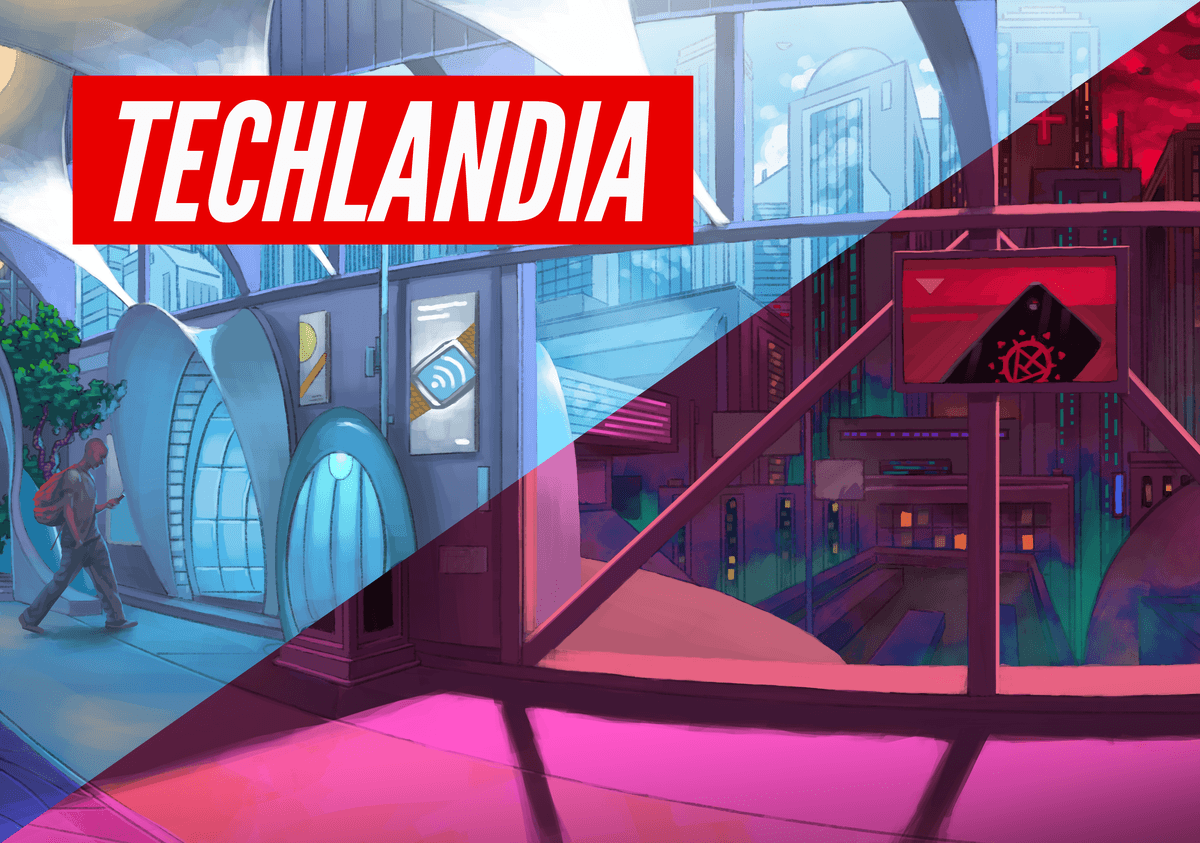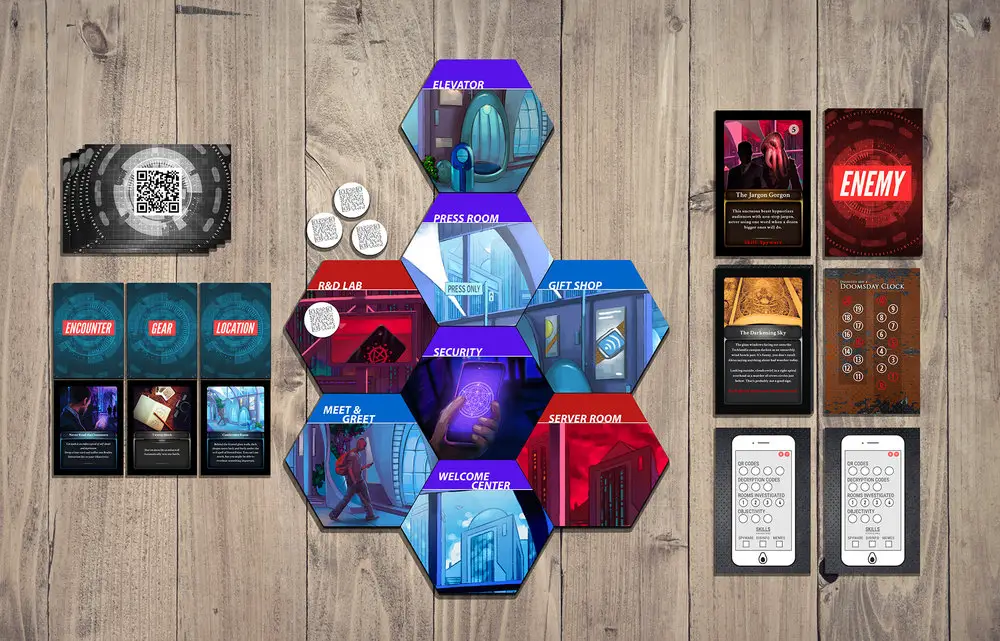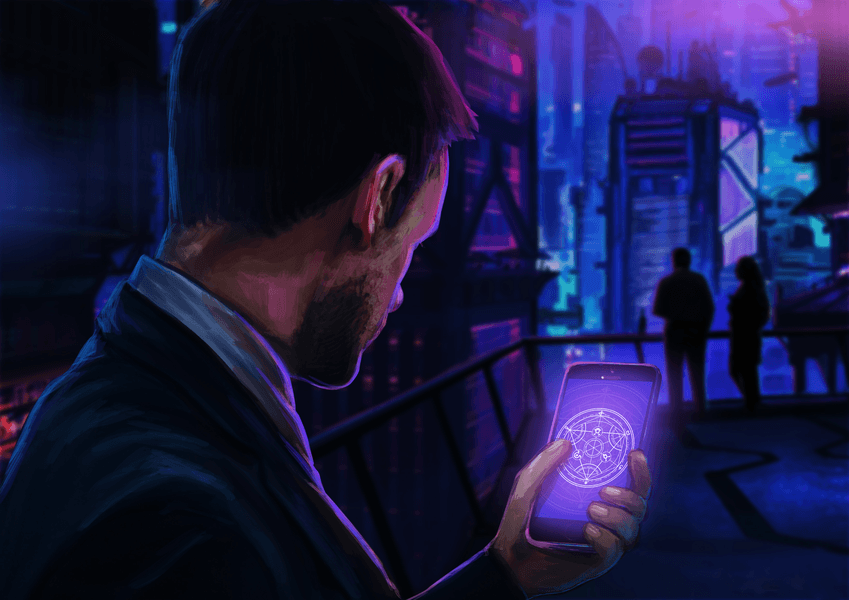Hello there everybody! Today I’m returning to the world of tabletop gaming! And, for the very first time, I’ll be tackling a game not based on already existing IP! So that’s neat, always nice to try something new.
Today we’re taking a look at Techlandia, a card based game (sort of, we’ll get to it) designed and published by Dan Ackerman, a technology editor for CNET who poured his experience in tech journalism into the game. You and up to three other players will be playing as tech bloggers, sneaking into the campus of the Techlandia Corporation to investigate the launch of their new smartphone, the Techlandia TX-1. It’s an interesting premise, and an interesting game so…let’s talk about it.
Presentation

First things first, let’s discuss how the game looks. I can quite happily say that everything about this game has been well constructed. From the box to the full color rulebook (complete with a TL;DR on the back) to the cards and the player pieces, this is a well crafted game. Crafted with love, even.
…sorry, couldn’t resist.
Dad jokes aside, this is is a well made game when talking purely about function. And the art for the various pieces is quite good…there’s just not a lot of it.
Oh, every player token has its own design, and the locations on the map all have their own art that’s well made and easily recognizable. But beyond that? Every ‘gear’ card has the exact same piece of art, whether said gear is a spare battery, a PR guy owing you a favor, or CBD oil. Every ‘enemy’ card, from the Gorgon to the Intern, has the same art. Every ‘encounter’ card has the same art, as does every ‘investigation’. And since every card has what type it is emblazoned on the back, it’s not like this was necessary for differentiating between them.
I do understand that this is an indie game, and that meant there was a lower budget and a smaller team. It makes perfect sense to pull back a little on the art, and stick to the essentials. The art is all good, and the game pieces and cards are all good to look at. The lack of variety might be a little disappointing, but it is by no means a deal breaker. And the text on the cards is quite well done too, all interesting and creative, fitting the themes of the game quite nicely.
So, all in all, good presentation, even if the cards are a little repetitive in the art department.
Setting Up

Now then, let’s talk about setting up this game. There’s not a board, exactly, but there is a map of Techlandia’s campus for you to set-up and move the pieces on. It’s made up of hexagonal cardboard tiles, of which there are twelve. Four of them (Welcome Center, Security, Press Room, and Elevator) are going to be laid out (in that order, in a vertical row) for every game, which leaves you with eight other tiles. From these, the player(s) draw four, and put them next to the vertical ones, giving you a map of eight tiles to play on.
After that, each player will need to select their player token, draw five gear cards, and grab a ‘dashboard card’ (a large card with the image of a smartphone on it), which they will use to mark their progress, and to declare their combat skill at the beginning. The locations cards that match to the location tiles in use are then shuffled and placed face down with the other cards, a marker is placed on the red ’20’ on the large ‘Doomsday Clock’ card, the large ‘Lore’ cards are set-up so the one that says ‘Read this card when the Doomsday Clock is set to 20.’ is on top, and the game can begin.
Gameplay
At its heart, Techlandia is a dungeon crawler. The goal of the game is to get to the elevator, and go down to the subterranean auditorium where the titular company will be unveiling their possibly evil smartphone to the press. You weren’t invited though, so you’ll need to get past the security checkpoint. And in order to do that, you’re going to need to investigate the four rooms the player(s) picked to add to the map for QR code fragments, and beat the enemies on the map to collect the decryption keys. And you need to be at the elevator before the Doomsday Clock counts down from twenty to zero.
To begin the game, one reads aloud the campaign setup text at the beginning of the rule book (said book politely requesting you to do so in a ‘cool movie trailer guy voice’) and put your blogger on the Welcome Center tile. Then you flip the top most ‘Lore’ card, read it aloud, and begin play.
There’s no set way to decide what order you go in, but the order must remain the same for the entirety of the game. Each player’s turn consists of up to two actions, and when everyone’s had their turn the round is over and the marker on the Doomsday Clock is moved down one number. There’s a variety of actions possible, all centered on advancing to the main goal of the game, from moving between rooms to investigating said rooms to fighting enemies. However, actions taken as a requirement of a ‘gear’ or ‘encounter’ card, or while resolving the effects of the former cards, are freebies and do not count against your action total. You can also go to the Press Room to get new ‘gear’ cards, though you can’t have more than seven and this does take up an action.

You can move about the map as you desire, but can only move to tiles adjacent to the one you’re currently in. There are three types of room tiles-purple, blue, and red. Purple rooms are the four that are required for the game, and cannot be investigated. Blue rooms are safer to investigate, while red are Secure and thus harder to investigate.
Investigation itself is fairly simple. There’s a deck of ‘investigation’ cards, and you simply draw the top card and it’ll say if you succeeded or failed and give further instructions, generally with a further penalty for failure if you’re in a red room. There are five failure and five success cards, so your odds are fairly decent unless you’ve offended the shuffling gods recently. Successes will always ‘spawn’ a QR code, though depending on the card it may spawn it in a room you’re not in. And sometimes they’ll spawn an enemy piece on the map as well, though where depends on the card once again.
Failure cards will make you draw an ‘encounter’ card, which are almost always negative, trending towards forcing you to move to a different room or to lose a ‘gear’ card most frequently. If you fail in a red room, you’ll often be forced to draw two cards.
Occasionally, enemies will be ‘spawned’ onto the map, most frequently by successful investigations but sometimes by encounter cards, though at round five a more powerful monster automatically spawns. Combat happens whenever you’re in the same room as an enemy and still have an action left, and is fairly simple. Each enemy has a number in the top right corner of their card, and a skill at the bottom. You roll a six sided die, and if you rolled a number the same as or higher than the one on the card you defeat the enemy. And if your skill that you picked at the start is the same as their skill then you get to add a one to the number you rolled (so if you rolled a four and have the same skill then it counts as rolling a five).
Your health is measured by an ‘Objectivity’ bar on your player card. There’s three points on it. If you lose three fights, you will become a ‘Fanboy’, and instead of trying to progress your job will be to get in the other players’ faces and make them spend one action sending you back to the Welcome Center. However, when the Doomsday Clock next marks a red space (20, 15, 10, 5, 1, and 0) you will stop being a ‘Fanboy’ and pick back up where you left off. Losing combat causes problems, but it’s not going to make you lose the game at least.
So, if combat’s not an automatic game over, is there any mechanic that can make you lose? Yep! The QR code fragments you’ve been collecting? Once you have four, you can go to the elevator and pick from the QR code card deck. For this you’ll need to use your actual smartphone and a QR code reader app (had to go and install one myself for this review) and it’ll tell you if you have the proper QR code or not. There’s four cards and only one is correct, and if you pick the wrong one you get an automatic game over.
However, it’s not as unfair as it might seem. Every time you win in combat you get a Decryption Code. each one works as a do-over of sorts. If you pick the wrong one, you can use a Decryption Code to try again. You can try as many times as you want in a single turn, so there’s no problems there. You just have to balance the risks of combat with the safety of getting the right code.
If you get the right code, then congratulations, you win and the game is over! If none of you did by the twentieth round, then the game ends and everybody lost.
Final Thoughts
Techlandia is a well thought out, well constructed, and honestly fun game. I had a lot of fun playing it for this review, and I look forward to playing it in the future. It’s not flawless, but its strengths far exceed those flaws. And it hits the perfect sweet spot between being more complex than your typical Milton-Bradley affair but not so much more complex it’s off putting to more casual board game fans.
So yeah, if tongue in cheek pokes at tech culture and Lovecraft-light are your thing, give it a look! You won’t be disappointed!
[rwp_box_criteria id=”0″]
You can pick up a copy of Techlandia from the game’s site.
Images Courtesy of Dan Ackerman and OhSwell LLC
Have strong thoughts about this piece you need to share? Or maybe there’s something else on your mind you’re wanting to talk about with fellow Fandomentals? Head on over to our Community server to join in the conversation!

